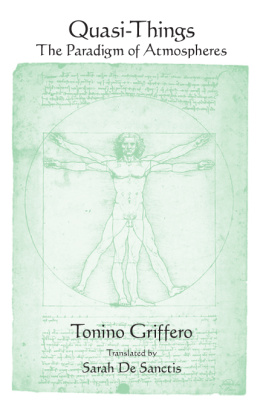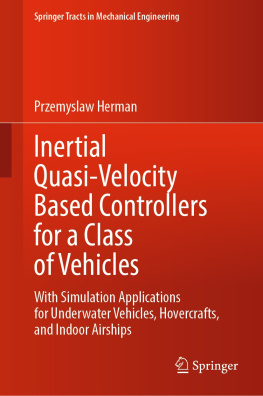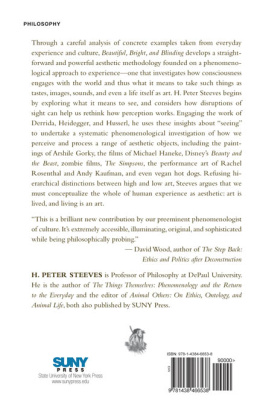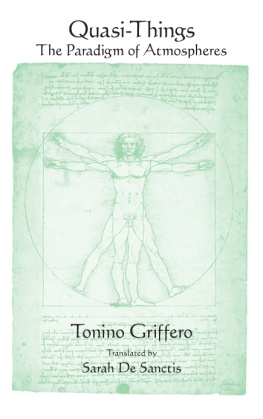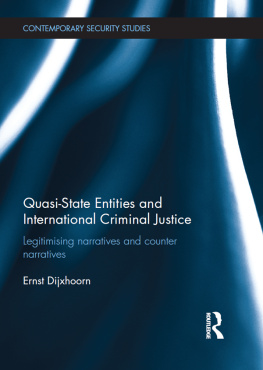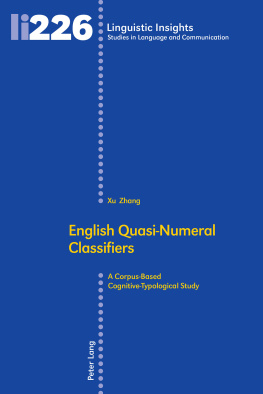Quasi-Things
SUNY series in Contemporary Italian Philosophy
Silvia Benso and Brian Schroeder, editors
Quasi-Things
The Paradigm of Atmospheres
Tonino Griffero
Translated by Sarah De Sanctis
Original Italian edition: Quasi-cose. La realt dei sentimenti (Bruno Mondadori, 2013).
Published by State University of New York Press, Albany
2017 State University of New York
All rights reserved
Printed in the United States of America
No part of this book may be used or reproduced in any manner whatsoever without written permission. No part of this book may be stored in a retrieval system or transmitted in any form or by any means including electronic, electrostatic, magnetic tape, mechanical, photocopying, recording, or otherwise without the prior permission in writing of the publisher.
For information, contact State University of New York Press, Albany, NY
www.sunypress.edu
Production, Jenn Bennett
Marketing, Michael Campochiaro
Library of Congress Cataloging-in-Publication Data
Names: Griffero, Tonino, author
Title: Quasi-things : the paradigm of atmospheres / Sarah De Sanctis, translator.
Description: Albany : State University of New York Press, [2017] | Series: SUNY series in contemporary Italian philosophy | Includes bibliographical references and index.
Identifiers: ISBN 9781438464053 (hardcover : alk. paper) | ISBN 9781438464077 (e-book)
Further information is available at the Library of Congress.
10 9 8 7 6 5 4 3 2 1
Contents
Preface
Fortunately, there first exists (apart from the light waves and nerve currents) the coloring and shine of things themselves, the green of the leaf and the yellow of the grain field, the black of the crow and the gray of the sky (Heidegger, 1967, 210).
Where I Started From: A Pathic Aesthetics
M y journey from an aesthetics of atmospheres to an ontology of quasi-things has its frame of reference in the ambitious project of a pathic aesthetics. By pathic I do not mean pathetic or pathological, but rather the affective involvement that the perceiver feels unable to critically react to or mitigate the intrusiveness of. This very involvement is, for me, the core of the aesthetic sphere (in the etymological sense of aisthesis )much more so than art and beauty. Philosophically rehabilitating pathicity means valorizing the ability to let oneself goa skill so rare today that it appears surprisingly (and critically) very relevant nowadays; one could sum it up as the ability to be a means of what happens to us rather than subjects of what we do. This skill was obviously misunderstood by the rationalistic post-Enlightenment dogma of subjective sovereignty and finalistic action; and yet it is the main heuristic instrument of a pathic aesthetics. The practicability of the latter, though, entirely depends on our ability to welcome what happens to us, whether we like it or not, resisting the temptation both to transform the given into something done and to seek shelter from this contingency in (now compromised) late-Romantic nostalgias.
where the genitive is both subjective and objectiveconceiving it as a non-gnostic but, indeed, pathic phenomenology (Straus). For this very reason, it is finally free from what is only one of the many possible conceptions of aestheticsthat of philosophy or even metaphysics of art. In fact, classic aesthetics is (a) idealistic in focusing on the work and its supposed autonomy, (b) metaphysical in considering art and beauty sub specie aeternitatis , (c) bourgeois in its full adherence to the process of civilization (through abstraction) of the European elite, (d) intellectual in focusing on judgment or interpretation rather than experience and in misunderstanding the role of felt-bodily sensitivity in the name of the (Kantian) alibi of disinterested pleasure. In short, classic aesthetics is governed by the same estrangement from and of nature that we find in the hard sciences and in the Enlightenment apology of the (alleged) autonomy of the subject.
However, as soon as one abandons this aesthetics from above and traces artworks back to (at most) exemplary cases of sensible perception, one sees that it is possible to avoid the frustrations caused both by transcendentalismwhich is always bound to the analysis of the conditions of possibilityand by interpretationism (hermeneutics and semiotics), which is always bound to a necessarily deferred sense with respect to the presence. My pathic aesthetics, instead, intends to remain, against this twofold bad infinity, as faithful as possible to the presenceto the way in which appearances resound in our lived-body. My itinerary mainly consists in prescinding from special things such as artworks and from the traditional categories of aesthetics (beautiful, sublime, genius, etc.) so as to rather investigate atmospheric feelings in the context of todays aestheticization of the lifeworld and the so-called diffuse design, typical of late capitalist societies. The analysis of situations and atmospheric perceptions, constituting the first step of this wished-for pathic aesthetics, introduces us to the entities that, without being full objects, are present and active on us.
Therefore, I am interested in our ordinary (nave) sensible experiences, especially when they are involuntary.
The expressive qualities that, radiating atmospheres, become quasi-things are both particular natural phenomena (twilight, luminosity, darkness, the seasons, the wind, the weather, the hours of the day, the fog, etc.) and relatively artificial phenomena (townscape, music, soundscape, the numinous, dwelling, charisma, the gaze, shame, etc.). These qualities are salient not despite being apparent and ephemeral, but precisely because of that. And yet, for that very reason, Western thought (and sometimes common sense) considers them devoid of reality as opposed to full things, which are endowed with borders, separated from others, perduring in time, and are normally inactive if not touched. The present pathic and atmospherological aesthetics, which is (broadly) realist in rejecting the lazy explanatory hypothesis of associationist and projectivist type, emphasizes instead the cooperative relationship between perception and the more nuanced dimension of quasi-things, which, just like the ecstasy of things, emotionally tune their surroundings. I want to offer an initial aesthetological and philosophical analysis of this pathic area, intermediate (in between indeed) but predualistic.
The core of this in between, however, is always the felt- or lived-body ( Leib ) (seek to rehabilitate the specifically aesthetological paradigm of certainty, thought of as experientia vaga without rules, irreducible to an etiologic and genetic approach. However vague, because it underscores our affective hetero-determination, this experiential and sensible certainty attests our being-in-the-world better than other, traditionally privileged, states (including the cogito ).
In short: we must learn to experience pathically (in the right way), no longer regarding teleological efficiency as a phenomenologically privileged path. We must pay attention not to our role as subjectswhich has been pathologically overestimated by modernity with well-known negative consequencesbut to the pathic to me (or the perceptological me) that precedes egological solidification, which as such is fatally destined to the dualism typical of cognitivism. Having this program in mind, Moreover, it is known that what happens to us hetero-determines us much more violently when we fight it than when we abandon ourselves to it ( cum grano salis ). So this is a chance to see affective involvement as potentially leading to emancipation rather thanas our paranoid culture claimsoccult and alienating mediation.

